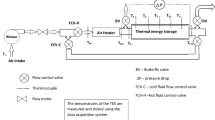Abstract
In this paper, heat transfer of the ceramic honeycomb regenerator was numerically simulated based on the computational fluid dynamics numerical analysis software CFX5. The longitudinal temperature distribution of regenerator and gas were obtained. The variation of temperature with time was discussed. In addition, the effects of some parameters such as switching time, gas temperature at the inlet of regenerator, height of regenerator and specific heat of the regenerative materials on heat saturating time were discussed. It provided primarily theoretic basis for further study of regenerative heat transfer mechanism.
Similar content being viewed by others
References
Gupta, A K. Thermal Characteristics of Gaseous Fuel Flames Using High Temperature Air. Journal of Engineering for Gas Turbines and Power, 2004, 26: 9–19
Dragutinovic, G D, Baclic, B S. Operation of Counterflow Regenerators. New York: Computational Mechanics Publications, 1998
Hausen, Helmuth. Heat Transfer in Counterflow, Parallel Flow and Cross Flow. New York: McGraw-Hill, 1983
Zarrinehkafsh, M T, Sadrameli, S M. Simulation of Fixed Bed Regenerative Heat Exchangers for Flue Gas Heat Recovery. Int. J. Applied Thermal Engineering, 2004, 24(2–3): 373–382
Park, Poo Min, Cho, Han Chang, Shin, Hyun Dong. Unsteady Thermal Flow Analysis in a Heat Regenerator with Spherical Particles. Int. J. Energy Res., 2003, 27: 161–172
Françoise, Duprat, Guadalupe, Lopez L. Comparison of Performance of Heat Regenerators: Relation between Heat Transfer Efficiency and Pressure Drop. Int. J. Energy Res., 2001, 25: 319–329
Ning, Dihuai, Zhao Xianru, He Guangbiao, et al. An Experimental Study on Amco Reversing Combustion Device. Energy for Metallurgical Industry, 1994, 13(2): 37–41
Wen, Liangying, Zhang, Zhengrong, et al. Experimental Study on Heat Transfer Characteristics of Regenerator of the Regenerative Burner. Iron and Steel, 2002, 37(7): 54–58
Lu, Wei, Ma, Xiao Qian. Study on Flow Characteristics of Heat Exchange Element with Porous Media. Iron and Steel, 2001, 36(6): 56–59
Li, Jianshu. Research on Heat Transfer in Ceramic Honeycomb Regenerator: [Master Thesis]. Beijing: Beijing Institute of Civil Engineering and Architecture, 2003
Author information
Authors and Affiliations
Rights and permissions
About this article
Cite this article
Jia, L., Mao, Y. & Yang, L. Temperature distribution and heat saturating time of regenerative heat transfer. J. of Therm. Sci. 15, 175–180 (2006). https://doi.org/10.1007/s11630-006-0175-7
Received:
Issue Date:
DOI: https://doi.org/10.1007/s11630-006-0175-7




